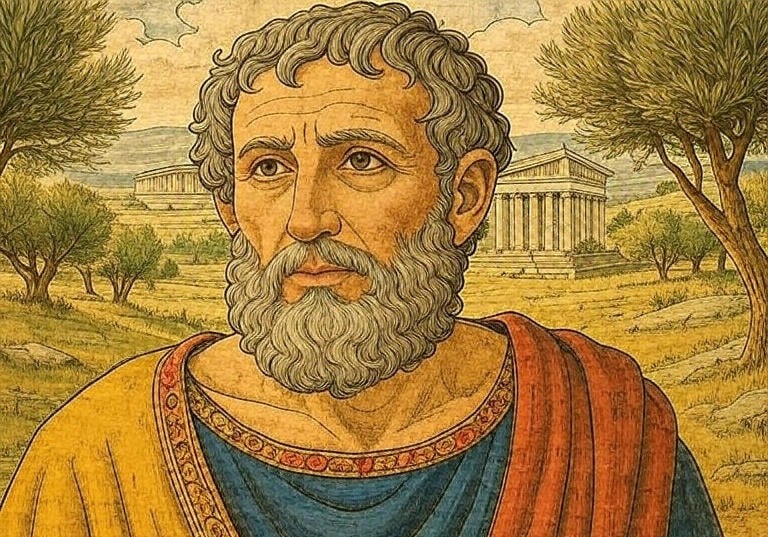

Strato of Lampsacus was an ancient Greek philosopher who conducted experiments on air pressure and vacuums at a time when most people believed that the gods controlled all of nature.
He was a man who lived over 2,000 years ago, yet he engaged in the same type of hands-on science that modern physicists practice today. Despite being an incredibly forward-thinking experimental scientist, he is barely mentioned in most history books.
Most people can name Plato, Aristotle, and perhaps Socrates, if they know a few things about ancient Greece. But Strato? Not so many. This is honestly a shame, because this man from Lampsacus (which is now in modern-day Turkey) was quietly revolutionizing how humans understood the physical world while everyone else was still arguing about abstract ideas.
He was born around 335 BC in what was then a pretty wealthy Greek trading city. Lampsacus sat right on the Hellespont, so Strato grew up watching ships come and go, probably observing all sorts of mechanical devices and engineering solutions that traders brought from across the Mediterranean. That early exposure to practical problem-solving might explain why he became so interested in actually testing things.
When Strato arrived in Athens to study at Aristotle’s famous Lyceum, the city was going through some serious political chaos. Alexander the Great had died in 323 BC, and everyone was trying to grab pieces of his vast empire. The philosophical schools had become islands of stability in a sea of chaos, where intellectuals could focus on learning instead of worrying about which warlord would march through town next.
Theophrastus ran the Lyceum at the time, and it still had its reputation as the go-to place for anyone serious about natural philosophy. However, when Strato eventually took over around 287 BC, things shifted dramatically. Where Aristotle had been interested in virtually everything—politics, poetry, biology, and more—and Theophrastus had made his mark studying plants and human character, Strato focused extensively on what we would now call physics.
His colleagues started calling him “Strato the Physicist,” quite a novel concept at the time. Although the word “physics” existed, it was not yet a distinct field of study; everything was known as “natural philosophy.” By giving him that nickname, they acknowledged that he was engaging in something different, more focused, and experimental than what was familiar to them.

It is not uncommon to hear that ancient Greeks were all about theory and never bothered with actual experiments. However, Strato essentially changed that stereotype completely. While Aristotle had stated that heavier objects fall faster than lighter ones—without bothering to test—Strato decided to investigate what happens when you drop objects.
His experiments with falling objects came nearly 2,000 years before Galileo’s famous demonstration at the Tower of Pisa. Later authors, such as Simplicius, mentioned that Strato observed how water, dropping from a rooftop, accelerates as it falls and separates into drops during its fall—an observation that challenged Aristotle’s belief. Strato discovered that weight alone doesn’t determine how fast something falls, which completely contradicted what had been accepted as an obvious truth for centuries.
But his work with air and pneumatics was even more revolutionary. Strato demonstrated that air has weight and occupies space. Think about trying to explain air pressure to someone who has never heard of molecules or atmospheric layers – that is what he was dealing with at that time. Yet he managed to design experiments that made these invisible forces visible and understandable.
Strato constructed these ingenious devices with vessels and pumps to demonstrate how air could be compressed and manipulated. When people observed water being moved by what appeared to be empty space, they began to realize that the idea “nature abhors a vacuum” might not be accurate after all. Instead, Strato revealed that it was really about differences in air pressure, not about space.
The realization that air had weight and could be manipulated was significant for how people perceived the natural world. If air behaved mechanically, perhaps everything in nature followed mechanical principles rather than mysterious forces or divine intervention. Strato was essentially laying the groundwork for a materialist understanding of how things function—an idea that would not gain traction until the Scientific Revolution many centuries later.
Picture him in his workshop, surrounded by bronze tubes and water clocks and all sorts of measuring devices, methodically proving ideas that had been accepted as true and wise for generations wrong. It must have been both exciting and probably a little nerve-wracking to be overturning so much conventional thinking.

The influence of Strato’s work went beyond his immediate students at the Lyceum of Athens. His ideas about motion, weight, and mechanical forces began to appear in the works of engineers and inventors during the Hellenistic era. For example, the amazing mechanical devices that Hero of Alexandria created—water clocks and automatic temple doors that amazed visitors—were built on principles that Strato had first figured out through his scientific experiments
What is even more impressive is how his ideas reached the medieval Islamic world. Scholars like Al-Biruni were actively building on his ideas, paying special attention to Strato’s experimental methods. When developing their theories about motion and mechanics, they frequently referenced his work and approach to testing ideas, instead of merely debating them.
Through Arabic translations, Strato’s influence eventually made its way back to medieval Europe, where it became the foundation of a later Scientific Revolution. Medieval scholars in places like Paris and Oxford were reading about his experiments and starting to think that maybe this hands-on approach to understanding nature was worth pursuing after all.
